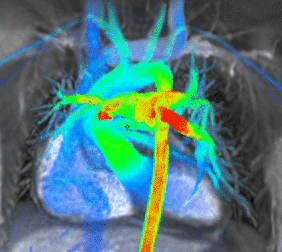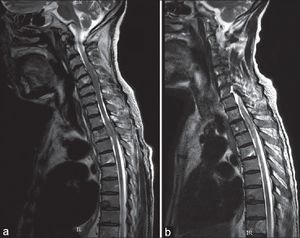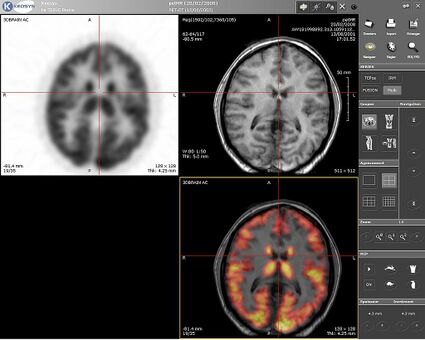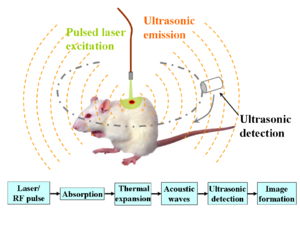Medical Imaging: Difference between revisions
No edit summary |
No edit summary |
||
| Line 33: | Line 33: | ||
* reduced radiation exposure, e.g. dynamic US after obtaining CT map | * reduced radiation exposure, e.g. dynamic US after obtaining CT map | ||
== | == Emerging Medical Imaging Technologies == | ||
[[File:PA.png|thumb|Schematic illustration of PA imaging]] | [[File:PA.png|thumb|Schematic illustration of PA imaging]]Many new medical imaging techniques are in existence including: | ||
* Radiography: x-ray phase-contrast imaging; x-ray dark-field imaging | |||
* CT: dark-field CT; deep-learning reconstruction; photon counting CT | |||
* Ultrasound: magnetomotive ultrasound (MMUS); superb microvascular imaging; ultrafast Doppler imaging; electromagnetic acoustic imaging (EMAI) | |||
* MRI: chemical exchange saturation transfer (CEST); hyperpolarised carbon-13 MRI; low-field MRI; MR fingerprinting | |||
* Nuclear medicine: total body PET system; immuno-PET | |||
* Miscellaneous: photoacoustic (PA) imaging; radiomics; terahertz imaging<ref>Radiopedia Emerging medical imaging technologies Available:https://radiopaedia.org/articles/emerging-medical-imaging-technologies-1?lang=gb (accessed 8.10.20220</ref> | |||
== Health Care Team == | == Health Care Team == | ||
Revision as of 03:18, 8 October 2022
Overview[edit | edit source]
Medical imaging is home to all diagnostic and therapeutic investigations/interventions conducted in a typical radiology department. It encompasses different imaging modalities and processes to image the human body for diagnostic, treatment and follow up purposes and plays an important role in initiatives to improve public health for all population groups[1]. It includes:
- Ultrasound (US)
- Computed tomography (CT)
- Nuclear medicine: is the practice of utilising microscopic amounts of radioactive substances to diagnose, monitor and treat disease.[2]
- PET (positron emission tomography) scan: an imaging test that involves the intravenous injection of a positron-emitting radiopharmaceutical, waiting to allow for systemic distribution, and then scanning for detection and quantification of patterns of radiopharmaceutical accumulation in the body. Usesd diagnose a variety of diseases (for example tumours, heart disease, brain disorders), provides a picture of the body working.[3]
- SPECT (Single photon emission computed tomography) similar to PET, is a nuclear medicine imaging techniques which provide metabolic and functional information unlike CT and MRI.[4]
- Hybrid modalities[5]See later in page
Necessity of Medical Imaging[edit | edit source]
Medical imaging is crucial in a variety of medical setting and at all major levels of health care. In public health and preventive medicine as well as in both curative and palliative care, effective decisions depend on correct diagnoses. Though medical/clinical judgment may be sufficient prior to treatment of many conditions, the use of diagnostic imaging services is paramount in confirming, correctly assessing and documenting courses of many diseases as well as in assessing responses to treatment
Imaging is a useful resource for many conditions and is an invaluable tool for physical therapists when used appropriately. It is important to know when imaging is appropriate, as unnecessary imaging will squander financial resources and increase potential for premature surgery.
Hybrid Imaging[edit | edit source]
Hybrid Imaging is the fusion of two (or more) imaging modalities to form a new technique. By combining the innate advantages of the fused imaging technologies synergistically, usually a new and more powerful modality comes into being
Existing hybrid imaging modalities comprise
- PET-CT
- SPECT-CT
- MRI-PET
- MRI-SPECT
- ultrasound and MRI
- ultrasound and CT
- MRI and CT
The general benefits of hybrid imaging include
- increased diagnostic accuracy
- a further step towards individualized medicine
- precise monitoring of interventional procedures
- reduced radiation exposure, e.g. dynamic US after obtaining CT map
Emerging Medical Imaging Technologies[edit | edit source]
Many new medical imaging techniques are in existence including:
- Radiography: x-ray phase-contrast imaging; x-ray dark-field imaging
- CT: dark-field CT; deep-learning reconstruction; photon counting CT
- Ultrasound: magnetomotive ultrasound (MMUS); superb microvascular imaging; ultrafast Doppler imaging; electromagnetic acoustic imaging (EMAI)
- MRI: chemical exchange saturation transfer (CEST); hyperpolarised carbon-13 MRI; low-field MRI; MR fingerprinting
- Nuclear medicine: total body PET system; immuno-PET
- Miscellaneous: photoacoustic (PA) imaging; radiomics; terahertz imaging[6]
Health Care Team[edit | edit source]
Imaging for medical purposes involves a team which includes the service of radiologists, radiographers (X-ray technologists), sonographers (ultrasound technologists), medical physicists, nurses, biomedical engineers, and other support staff working together to optimize the wellbeing of patients, one at a time. Appropriate use of medical imaging requires a multidisciplinary approach.[1]
Diagnostic Imaging for Body Regions[edit | edit source]
- Diagnostic Imaging of the Hip for the Physical Therapist
- Diagnostic Imaging of the Knee for the Physical Therapist
- Diagnostic Imaging of the Ankle and Foot for the Physical Therapist
- Diagnostic Imaging of the Shoulder
References[edit | edit source]
- ↑ 1.0 1.1 WHO Diagnostic Imaging Available from: https://www.who.int/diagnostic_imaging/en/(accessed 7.4.2021)
- ↑ Radiopedia Nuclear medicine Available:https://radiopaedia.org/articles/nuclear-medicine (accessed 8.10.20220
- ↑ Radiopedia PET Available: https://radiopaedia.org/articles/positron-emission-tomography(accessed 8.10.2022)
- ↑ Radiopedia SPECT vs PET Available:https://radiopaedia.org/articles/spect-vs-pet (accessed 8.10.2022)
- ↑ Radiopedia Modalities Available from:https://radiopaedia.org/articles/modality?lang=us (accessed 7.4.2021)
- ↑ Radiopedia Emerging medical imaging technologies Available:https://radiopaedia.org/articles/emerging-medical-imaging-technologies-1?lang=gb (accessed 8.10.20220










